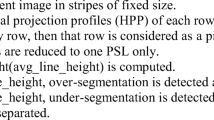Abstract
In the recognition of the historical handwritten Modi documents, character segmentation is a significant task. The complexity in Modi character segmentation is increased because of non-uniformed, unconstrained, stylish and cursive writing nature of the Modi text. Here, a modified and robust character segmentation approach is presented for the unified clusters of archaic handwritten Modi script documents. Three different strategies are presented here to tackle the different challenges in segmentation of these clusters. The selection strategy is based on the degree of connected component overlap ratio. Highly overlapping characters are segmented by employing the local zoning-based background pixel intensity method. Foreground pixel intensity and vertical projection profile are analysed to segment the partial overlapping/touching characters and entirely touching characters respectively. Experiment was conducted using the handwritten unified Modi characters clusters. It has been proved that with the proper selection strategy, the proposed unified characters cluster segmentation system achieves 86.33% segmentation accuracy with reduced bad segmentation rate.
Access this chapter
Tax calculation will be finalised at checkout
Purchases are for personal use only
Similar content being viewed by others
References
Ali AAA, Suresha M (2020) Survey on segmentation and recognition of handwritten Arabic script. SN Comput Sci 1:192. https://doi.org/10.1007/s42979-020-00187-y
Bag S, Krishna A (2015) Character segmentation of Hindi unconstrained handwritten words. In: International workshop on combinatorial image analysis. Springer, Cham, pp 247–260
Basu S, Chaudhuri C, Kundu M, Nasipuri M, Basu DK (2012) Segmentation of offline handwritten Bengali script. arXiv preprint arXiv:1202.3046
Behera S, Pradhan A, Majhi B (2017) A novel clustering based fuzzy approach for character segmentation in handwritten Odia scripts. In: Image information processing (ICIIP). IEEE, pp 1–6
Bhowmik TK, Roy A, Roy U (2005) Character segmentation for handwritten Bangla words using artificial neural network. In: Proc 1st IAPR TC3 NNLDAR
Choudhary A, Rishi R, Ahlawat S (2013) A new character segmentation approach for off-line cursive handwritten words. Procedia Comput Sci 17:88–95
Deshmukh MS, Kolhe SR (2019) A hybrid character segmentation approach for cursive unconstrained handwritten historical Modi script documents. In: International conference on sustainable computing in science, technology & management (SUSCOM-2019). SSRN Elsevier Digital Library
Deshmukh MS, Kolhe SR (2020) A modified approach for the segmentation of unconstrained cursive Modi touching characters cluster. In: International conference on recent trends in image processing and pattern recognition, CCIS, Springer
Deshmukh MS, Patil MP, Kolhe SR (2017) A dynamic statistical nonparametric cleaning and enhancement system for highly degraded ancient handwritten Modi Lipi documents. In: Advances in computing, communications and informatics (ICACCI). IEEE, pp 1545–1551
Deshmukh MS, Patil MP, Kolhe SR (2017) The divide-and-conquer based algorithm to detect and correct the skew angle in the old age historical handwritten Modi Lipi documents. Int J Comput Sci Appl 14(2)
Deshmukh MS, Patil MP, Kolhe SR (2018) A hybrid text line segmentation approach for the ancient handwritten unconstrained freestyle Modi script documents. Imaging Sci J 66(7):433–442
Garg NK, Kaur L, Jindal MK (2015) Segmentation of touching modifiers and consonants in middle region of handwritten Hindi text. Pattern Recognit Image Anal 25(3):413–417
Golait Snehal S, Malik L (2016) Handwritten Marathi compound character segmentation using minutiae detection algorithm. Procedia Comput Sci 87:18–24
Jindal K, Kumar R (2017) A novel shape-based character segmentation method for Devanagari script. Arab J Sci Eng 42(8):3221–3228
Kapoor S, Verma V (2014) Fragmentation of handwritten touching characters in Devanagari script. Int J Inf Technol Model Comput (IJITMC) 2:11–21
Kavallieratou E, Stamatatos E, Fakotakis N, Kokkinakis G (2000) Handwritten character segmentation using transformation-based learning. In: ICPR. IEEE, p 2634
Kavitha AS, Shivakumara P, Kumar GH, Lu T (2017) A new watershed model based system for character segmentation in degraded text lines. AEU-Int J Electron Commun 71:45–52
Kumar M, Jindal MK, Sharma RK (2014) Segmentation of isolated and touching characters in offline handwritten Gurmukhi script recognition. Int J Inf Technol Comput Sci 6(2):58–63
Kurniawan F, Rahim MSM, Daman D, Rehman A, Mohamad D, Mariyam S (2011) Region-based touched character segmentation in handwritten words. Int J Innov Comput Inf Control 7(6):3107–3120
Palakollu S, Dhir R, Rani R (2012) Handwritten Hindi text segmentation techniques for lines and characters. Proceedings of the world congress on engineering and computer science 1:24–26
Peng G, Yu P, Li H, Li H, Zhu X (2017) A character segmentation algorithm for the palm leaf manuscripts. In: Computational intelligence and applications (ICCIA). IEEE, pp 354–358
Roy A, Bhowmik TK, Parui SK, Roy U (2005) A novel approach to skew detection and character segmentation for handwritten Bangla words. In: Digital image computing: techniques and applications, 2005. DICTA’05. Proceedings 2005. IEEE, p 30
Saba T, Rehman A, Elarbi-Boudihir M (2014) Methods and strategies on off-line cursive touched characters segmentation: a directional review. Artif Intell Rev 42(4):1047–1066
Sharma P, Sachan MK (2017) A review on character segmentation of touching and half character in handwritten Hindi text. Int J Adv Res Comput Sci 8(3)
Tamhankar PA, Masalkar KD, Kolhe SR (2020) A novel approach for character segmentation of offline handwritten Marathi documents written in MODI script. Procedia Comput Sci 171:179–187
Walawage KSA, Ranathunga L (2018) Segmentation of overlapping and touching Sinhala handwritten characters. In: 2018 3rd international conference on information technology research (ICITR). IEEE, pp 1–6
Author information
Authors and Affiliations
Editor information
Editors and Affiliations
Rights and permissions
Copyright information
© 2022 The Author(s), under exclusive license to Springer Nature Singapore Pte Ltd.
About this paper
Cite this paper
Deshmukh, M.S., Kolhe, S.R. (2022). A New Approach for Unified Characters Cluster Segmentation of Ancient Handwritten Modi Documents. In: Bansal, J.C., Engelbrecht, A., Shukla, P.K. (eds) Computer Vision and Robotics. Algorithms for Intelligent Systems. Springer, Singapore. https://doi.org/10.1007/978-981-16-8225-4_39
Download citation
DOI: https://doi.org/10.1007/978-981-16-8225-4_39
Published:
Publisher Name: Springer, Singapore
Print ISBN: 978-981-16-8224-7
Online ISBN: 978-981-16-8225-4
eBook Packages: Intelligent Technologies and RoboticsIntelligent Technologies and Robotics (R0)




